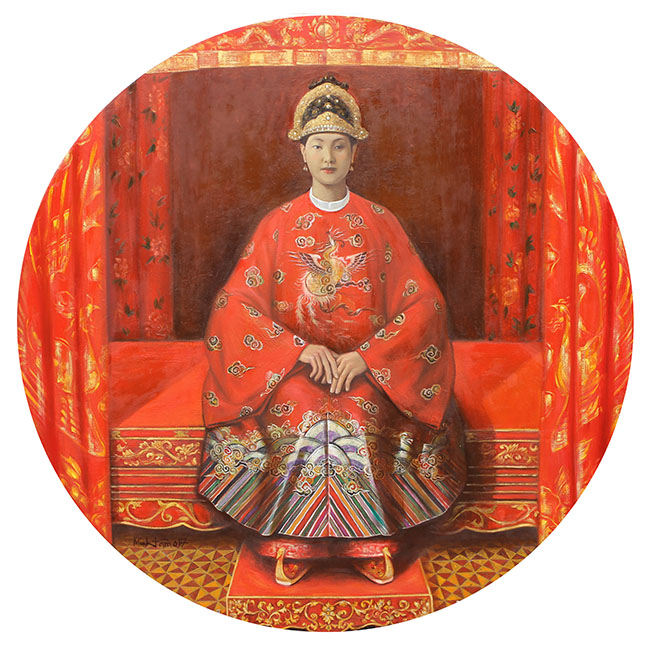
Curatorial Essay of Exhibition House of Nguyen II
Tuesday November 21st, 2017Trần Minh Tâm, Nam Phương Hoàng Hậu, Empress Nam Phuong, 2017, 2017, Oil, lacquer on wood, Sơn dầu, sơn mài trên gỗ, 122 x 122 cm
The first time art lovers and collectors became familiar with Tran Minh Tam’s portrayal of royal characters from the past was in 2013, when he introduced his House of Nguyen I series at Craig Thomas Gallery. The Nguyen Dynasty has a long line of historical personages who, according to the artist, “are already very famous in Vietnamese history.” Even so, during the four years between House of Nguyen I and today, Tran Minh Tam never stopped conducting research on Vietnam’s final dynasty. He continues to produce art through the medium of wood, oil and lacquer as a means to make tangible his research; thus comes his latest series House of Nguyen II in 2017.
In its essence, House of Nguyen II is part of the artist’s continuing effort to capture a royal past that is now far removed from the memory of most modern Vietnamese. But in all fairness, Minh Tam is not just an artist inspired by history. On the micro level, he seeks to achieve accuracy through attention to minute details such as the anatomy or the clothing of his characters; something he accomplished successfully in the first series. However, he has since experimented much further with story-telling, maneuvering different aspects of a painting from the obvious use of characters to the subtle hints found in decorative devices.
The legacy of the House of Nguyen is felt most strongly today in the city of Hue, its imperial capital from 1802 to 1945. On multiple visits to the ancient city, Tran Minh Tam never ceases to marvel at the magnificently complex royal architecture from the emperors’ time. “The relation between human and landscape is irrefutable. In a way I feel a profound melancholic longing for the now-absent human presence that used to occupy those spaces.” Tran Minh Tam instinctively tries to fill the void of those uninhabited spaces, but saying Minh Tam relies solely on mythical narratives from his research to do so would be incomplete.
Instead of generating a visual conceptualization that strictly follows the narrative of popular myths surrounding his subjects, Tran Minh Tam injects his own artistic imagination into different layers of representations in his depictions of these historical characters. Straying away from their political legacies, a version frequently told in mainstream history textbooks, the artist honors his royal subjects by emphasizing their human experiences, which include the universal emotions of grief, love, loss…in order to instill an empathetic wonder in the viewer. King Duy Tan and Madame Ho Thi Chi exemplifies this method and even shifts the typical focus on the emperors to make central an ostensibly peripheral female character. While emperor Duy Tan is only portrayed as a shadow over her shoulder, Madame Ho Thi Chi catches the eye in her green gown and in the gentle embrace of a peacock. The peacock has always been a symbol of elegance, grace, virtue, and was believed to be the manifestation on Earth of Fenghuang, the mythological bird that controls all celestial bodies. The painting demands of the viewer sympathy for the tragic life of a dignified woman whose virtue, intelligence and beauty could not save her from being a victim of her time.
Whereas Tam used to paint his first House of Nguyen I portraits on abandoned furniture, this time around he has fashioned his own wooden templates, shaping them in whichever way he wished. “Before, the size of the paintings was restricted by the size of the furniture piece I collected, but now, there’s more flexibility when it comes to how big the paintings can be. Or simply, the portraits emit more glory and splendor on newer pieces of wood.” Minh Tam’s words evince a contemporary mindset that values freedom of artistic interpretation in dealing with subjects from the past.
“Perhaps this series can be understood as a modern reckoning with our history,” says the artist reflecting on the House of Nguyen II collection. Looking forward, Tran Minh Tam wants to challenge himself with even more ambitious projects, such as painting the earliest emperors of the Nguyen Dynasty, with folk art being the only available source for references, or the wedding of emperor Bao Dai and empress Nam Phuong. Before that day comes, join us at Craig Thomas Gallery on the House of Nguyen II journey back in time, and admire the traditional art of lacquering performed by the hands of a contemporary artist working with realistic subjects from Vietnamese history.
Trinh Phuong Trang

